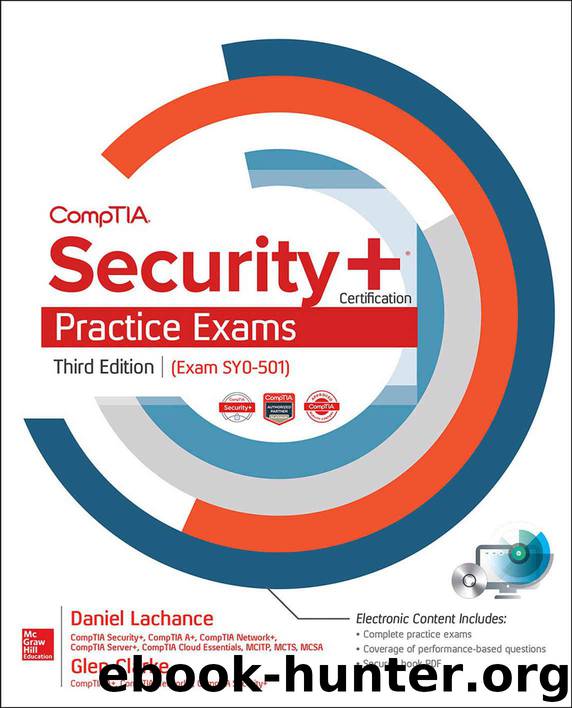CompTIA Security+ Certification Practice Exams, Third Edition (Exam SY0-501) by Lachance Daniel & Clarke Glen E

Author:Lachance, Daniel & Clarke, Glen E. [Lachance, Daniel]
Language: eng
Format: azw3
Publisher: McGraw-Hill Education
Published: 2017-08-18T04:00:00+00:00
A
QUICK ANSWER KEY
1. D
2. C
3. B
4. A
5. C
6. B, C
7. C, D, E
8. C
9. D
10. C
11. A
12. A
13. D
14. D
15. C
16. A
17. D
18. C
19. B
20. B
21. D
22. B
23. B
24. C
25. D
26. A, D
27. B
28. A
29. B
30. A
31. A
32. A, C, D
33. B
A
IN-DEPTH ANSWERS
1. D. Multifactor authentication involves more than one item to authenticate to a system, such as something you have (a card), something you know (a PIN), something you are (a fingerprint), or something you do (handwriting).
A, B, and C are incorrect. Bi-factor authentication is not a standard industry term (two-factor is, though). Biometric authentication requires a unique physical characteristic (something you are) such as a fingerprint scan, retinal scan, iris scan, voice recognition, or facial recognition. Location-based authentication uses your physical location or the device you are using as part of the authentication.
2. C. A virtual private network (VPN) creates an encrypted tunnel between a remote access client and a private network over the Internet. This would allow access to corporate database servers.
A, B, and D are incorrect. A modem converts between computer digital signals and analog signaling used by some portions of the public switched telephone network (PSTN) to allow remote access to a private network, but a modem itself does not provide secure remote access. Wireless local area networks (WLANs) that you configure would have a short range (a few hundred feet) and would not work for traveling users. An intranet is an internal private network that uses Internet technologies such as TCP/IP and HTTP web servers; it is not related to traveling users.
3. B. Voice over Internet Protocol (VoIP) transmits digitized voice over a TCP/IP network such as the Internet. As such, the only cost to both parties is that of your Internet connection.
A, C, and D are incorrect. A modem converts digital signals to analog, and vice versa; it is used to connect computers to the PSTN but is not well suited for multiple-party conference calls. Internet text chat and e-mail are not telephony solutions to conference calls.
4. A. Network access control (NAC) technology can be a hardware or software solution that requires user or device authentication prior to gaining network access.
B, C, and D are incorrect. Packet-filtering firewalls analyze packet headers to allow or block traffic already on the network; they don’t control who (or what) gains access to the network in the first place. Unto itself, Public Key Infrastructure (PKI) does not control network access. PKI certificates can be used to authenticate and secure network traffic and can be used with NAC solutions. Secure Sockets Layer (SSL) encrypts traffic that is already on the network.
5. C. Remote Authentication Dial-In User Service (RADIUS) servers are central user or device authentication points on the network. Authentication can occur in many ways, including Extensible Authentication Protocol (EAP) and Challenge Handshake Authentication Protocol (CHAP).
A, B, and D are incorrect. File servers host shared file and folder resources; they rely on users and devices already having network access. Active Directory is a replicated database of network resources
Download
This site does not store any files on its server. We only index and link to content provided by other sites. Please contact the content providers to delete copyright contents if any and email us, we'll remove relevant links or contents immediately.
Effective Threat Investigation for SOC Analysts by Yahia Mostafa;(7311)
Practical Memory Forensics by Svetlana Ostrovskaya & Oleg Skulkin(7015)
Machine Learning Security Principles by John Paul Mueller(6986)
Attacking and Exploiting Modern Web Applications by Simone Onofri & Donato Onofri(6654)
Operationalizing Threat Intelligence by Kyle Wilhoit & Joseph Opacki(6631)
Solidity Programming Essentials by Ritesh Modi(4471)
Microsoft 365 Security, Compliance, and Identity Administration by Peter Rising(4064)
Operationalizing Threat Intelligence by Joseph Opacki Kyle Wilhoit(3811)
Learn Computer Forensics - Second Edition by William Oettinger(3561)
Future Crimes by Marc Goodman(3505)
Building a Next-Gen SOC with IBM QRadar: Accelerate your security operations and detect cyber threats effectively by Ashish M Kothekar(3498)
Blockchain Basics by Daniel Drescher(3475)
Mastering Azure Security by Mustafa Toroman and Tom Janetscheck(3457)
Mastering Python for Networking and Security by José Manuel Ortega(3438)
Incident Response with Threat Intelligence by Roberto Martínez(3287)
The Code Book by Simon Singh(3056)
Mastering Bitcoin: Programming the Open Blockchain by Andreas M. Antonopoulos(2969)
Mobile App Reverse Engineering by Abhinav Mishra(2946)
From CIA to APT: An Introduction to Cyber Security by Edward G. Amoroso & Matthew E. Amoroso(2846)
